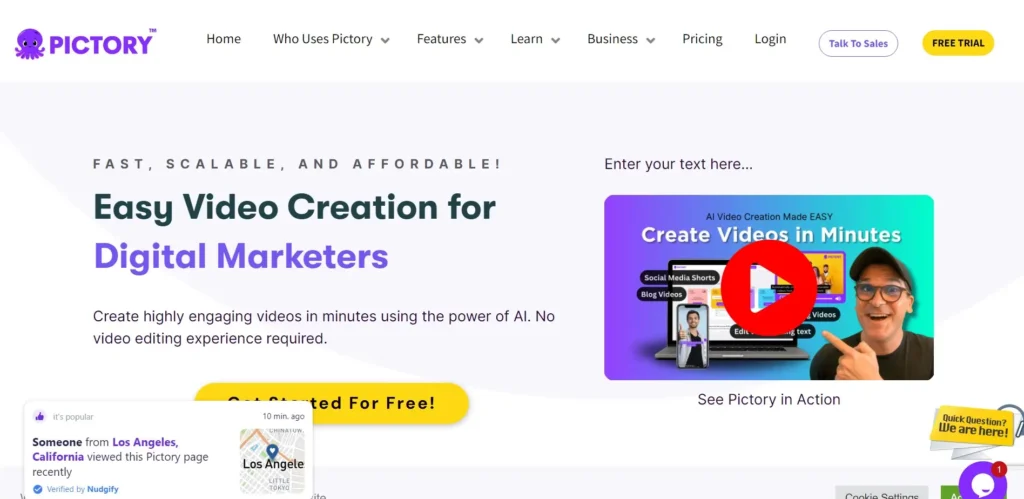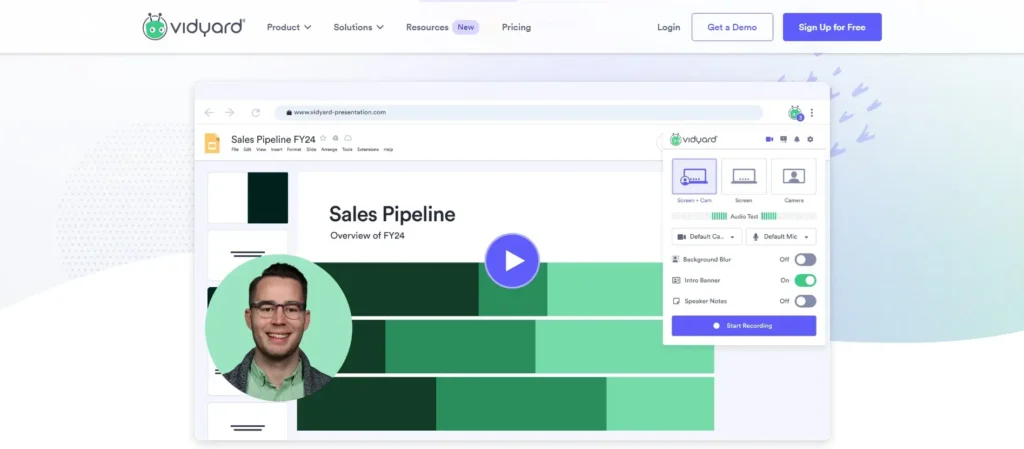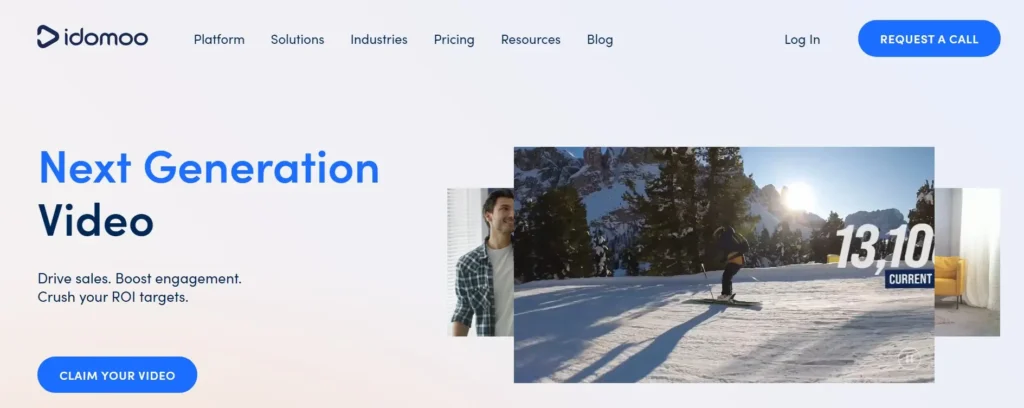Quick Summary
AI has disrupted video marketing by revolutionizing video marketing with the creation of personalized content, advanced analytics, automated editing, and a better viewer experience.
Of all these several benefits, however, increased engagement, improved ROI, and more efficient content production stand out.
Moreover, integrating AI into your video marketing strategy will ensure you have better targeting, higher conversion rates, and more potent campaigns.
AI and video marketing have come a long way from their inception. Today, AI is pushing them into a new creative and effective era.
I have been in active digital marketing for more than five years now, so I’ve seen how AI changed the way videos are created, distributed, and analyzed.
Below is an exhaustive report on 15 major ways Artificial Intelligence is Transforms Video Marketing today.
We shall go in-depth on all technologies, applications, and real-world impacts making a crescendo towards the future of video marketing, targeting the improvements of production processes and ultra-personalized experiences.
1. AI-Powered Video Creation
I can safely say that AI video creation tools, which I have tried several times, have significantly taken much of the time and resources that would have been used to produce high-quality video content.
Therefore, marketers do not need to be tech geeks or have deep pockets to create good videos.
Key innovations include:
- Automated video creation: AI creates short-form from text input; this is perfect for social media content.
- Scriptwriting: Thanks to these NLP algorithms, it has become easier for me to create these video scripts.
- Synthetic voice: Computer-generated voice-overs that muse is starting to sound more and more human.
Key AI video creation tools I’ve used:
- Synthesia: For creating AI-generated presenters
- Pictory.ai: Converts blog posts into really cool videos and video editing
- RunwayML: Advanced Video editing and special effects
My experience: I regularly use Pictory.ai for my everyday video creations. It saves me time and money. I am also able to edit videos and turn long videos into shorts.

Pros:
- Rapid content creation
- Cost-effective for multiple language versions
- Consistent quality across videos
Cons:
- Limited customization options
- May lack the personal touch of human presenters
2. Personalized Video Experiences
AI makes it possible for marketers to offer highly personalized video experiences at a massive scale, something that would be virtually impossible without it, considering time and resources.
In fact, I’ve implemented AI-driven personalization into my campaigns and have seen remarkable results.
Key applications include:
- Dynamic video content: AI can alter features in a video to suit viewer preferences or demographics.
- Personalized video recommendations: It’s like Netflix’s suggestion algorithm but for marketing content.
- Interactive video experiences: Videos that come with AI-powered chatbots so that viewers can participate while watching.
Tools I’ve used for personalized video:
- Vidyard: For creating personalized video messages
- Idomoo: For large-scale personalized video campaigns

Key benefits of AI-driven video personalization:
- Higher engagement rates
- Improved customer retention
- Increased conversion rates
3. AI-Enhanced Video Analytics
It is those times when view count and likes are not sufficient. To me, the analytic tools powered by artificial intelligence have revealed a lot of insights that nobody has ever had about viewer behavior and content performance.
Key applications include:
- Emotion detection—through AI facial expression analysis—reveals viewer sentiment.
- Additionally, speech-to-text analysis provides automatic transcription and analysis of spoken content in videos.
- Furthermore, object and scene recognition enables the identification of specific elements in videos to understand content performance.
- Finally, predictive analytics forecasts video performance based on historical data and current trends.
Top AI analytics tools I use:
- Tubular Labs: Deep audience analysis
- Peach: AI-driven content tagging and categorization
Key metrics AI helps analyze:
- Emotional response
- Attention hotspots
- Content relevance
- Predictive performance
4. Automated Video Editing
AI-powered editing tools have simplified post-production, and now I can deliver at a faster and more consistent level.
AI editing tools I rely on:
- Adobe Premiere Pro (with Sensei AI): Intelligent color grading and audio mixing
- Magisto: Quick, AI-generated edits of raw footage
Example: I used Magisto to condense one full day’s footage of an event into a 2-minute highlight reel. Artificial Intelligence selects relevant and interesting clips that fit just right with the background music, hence eliminating hours of manual video tweaking.
Benefits of AI in video editing:
- Drastically improved speeds in production
- Seamless consistency throughout an enormous number of videos
- Work fantastically with big data
5. AI-Driven Content Recommendations
One big way in which I have personally seen AI enhance viewer engagement time and watch time of the video content that I share is through the implementation of recommendation systems.
Tools I’ve implemented:
- Recombee: for building recommender systems in video recommendations
- Amazon Personalize: for conducting large-scale content suggestion systems
How AI recommendations work:
- Analyze viewer behavior and preference
- Identify patterns and similarities of users
- Recommend relevant content in real-time
6. AI-Powered Video SEO Optimization
Being a content creator myself, I have seen how video SEO is changing with AI. When you have a statistic like that—Cisco’s mind-boggling figure of video accounting for 82% of all internet traffic—optimizing video content for search engines could never be more paramount.
Key advancements:
- Automated transcription and closed captioning
- Video content analysis for better metadata generation
- AI-driven thumbnail selection for maximizing click-throughs
- Predictive keyword suggestions for video titles and descriptions
Tip: The AI-generated SEO elements should always be reviewed and fine-tuned for brand voice alignment and messaging.
AI tools I use for video SEO:
- TubeBuddy—AI-generated keyword suggestions; the tool optimizes tags automatically.
- VidIQ—Competitive analysis, including the prediction of trend
How AI enhances video SEO:
- Auto-suggest trends and search queries in the title and description
- Suggestions for most searched keywords and appropriate trending tags
- Competitor video performance and ranking factors analysis
- Performance prediction
Did you know? Video marketing greatly enhances SEO rankings and gets your content found, no matter where it will be used.
7. AI-Enhanced Video Storytelling
No one can deny the fact that video really helps drive home a message or information.
According to Zabisco, 95% of a message is retained by the people if it is shown through video, compared to reading it through text, wherein people will only retain 10%.
Now, AI is taking it further to help people get a more engaging narrative.
Key features:
- Upscaling of res video footage
- Noise reduction and color grading
- Frame rate conversion for smoother video play
- Automated background substitution/removal
AI storytelling tools I’ve experimented with:
- Articoolo: AI video scripts
- Narrativa: Data-driven storytelling
Benefits of AI in video storytelling:
- Beating writer’s block with AI ideas
- Data-driven storytelling that engages audiences
- Structuring a story that grips viewers
8. Automated Video Subtitles and Translations
Reaching out to the global audience comes in when there is consumption of over 1 billion hours of video content on YouTube daily. AI has made this process faster, easier, and accurate.
Key features:
- Real-time speech recognition and transcription enable immediate and accurate text conversion during video playback.
- Automated translation in several languages broadens the accessibility of your content to a global audience.
- Lip-synch technology for dubbed content ensures that audio matches the visual elements, enhancing viewer experience.
- Finally, context-aware translations that retain the original intent preserve the meaning and nuance of your message across different languages.
AI tools for subtitling and translating that I tap into:
- Rev.com (with AI-assisted transcription)
- DeepL for translations

Key advantages:
- Increased accessibility to deaf and hard-of-hearing viewers
- Increased reach across borders
- Increased SEO performance as it is text-based content
9. AI-Driven A/B Testing for Video Ads
As Mark Zuckerberg once said, “People are no longer reading, but they are watching.” With that change, video ads need to be optimized. AI has changed the way I do A/B testing for video advertisements.
Key applications:
- Programmatic ad placement based on real-time data analysis
- In-video context advertising
- Dynamic ad insertion into live video streams
- AI-powered A/B testing for video ad variations
Tools I use for AI-powered A/B testing:
- Facebook’s Dynamic Creative
- Google’s Video Experiments
How AI improves A/B testing:
- Tests multiple variables simultaneously
- Quickly identifies winning combinations
- Continuously optimizes based on real-time data
10. AI-enhanced video Analytics for Social Media
Video marketing has got its gold mine inside the four walls of the social media platform.
Videos on Facebook generate 10 times more than the combination of text and image posts put together. So are the figures when it comes to Instagram.
Video posts have more engagement rates than photo posts on Instagram. AI has been aiding marketers in using these channels to the fullest.
Benefits include:
- Trend prediction—with the help of data from social media and its search parts—enables accurate forecasting of upcoming trends.
- Furthermore, gap analysis regarding content—where the tool focuses on untouched spaces—helps identify content opportunities.
- Additionally, audience segmentation—which allows for devising targeted content that would cater to the right audience—ensures more effective marketing strategies.
- Finally, the best posting schedules, considering the engagement pattern, optimize the reach and impact of your content.
AI social media analytics tools I use:
- SAAS tools- The use of Sprout Social tools for AI insights
- Hootsuite Insights: powered by AI
What the AI is analyzing in the social video:
- The best time to post
- Themes from the content engaging your audience
- Video performance is important, especially when working with a brand that gives more intelligence than you.
- Predictive trends to help with content planning for the future
11. AI-Powered Influencer Identification for Video Collaborations
Influencer marketing, together with video content, can be said to be one of the most potent things. AI has changed how I find and partner with influencers for video collaborations.
Key benefits:
- Influencer selection becomes data-driven to ensure a better audience fit
- Detecting fake followers and fake engagement
- Predictions of how the campaign will perform when working with an influencer
- Automated outreach and campaign handling
AI influencer discovery tools I’ve used:
- Upfluence
- AspireIQ
How AI enhances influencer collaborations:
- It detects perfect matches of an audience to a brand.
- Additionally, it predicts the likelihood of potential campaign performance.
- Moreover, the analysis of influencers’ past video content focuses on authenticity and engagement.
12. Real-Time Video Personalization
Video is the future of content marketing,” as Gary Vaynerchuk said. Now, AI transcends boundaries further by personalizing video content in real-time.
AI-powered real-time personalization tools I’ve experimented with:
- Idomoo
- Photospire

Benefits of real-time video personalization:
- Firstly, increased viewer engagement leads to more interactions and interest in your content.
- Additionally, higher conversion rates result from effectively capturing and maintaining audience attention.
- Moreover, improved customer loyalty fosters long-term relationships and repeat interactions.
- Finally, standing out in crowded inboxes ensures that your content gets noticed and opens are maximized.
13. AI-Driven Video Content Planning
A content plan is always the very first thing to do for every marketing strategy. AI has transformed how I would personally conceptualize a video content calendar or even pick topics.
AI tools I use for content planning:
- BuzzSumo (with AI-powered content insights)
- MarketMuse
How AI aids in content planning:
- Firstly, filtering out trending topics and content gaps helps you stay relevant and address underserved areas.
- Additionally, recommending the right length and format for your content ensures that it meets audience preferences and platform requirements.
- Moreover, predicting audience reception allows you to tailor your content to better align with viewer expectations.
- Finally, recommending the best times and places to publish optimizes your content’s visibility and engagement.
14. Emotion AI in Video Marketing
Knowing how your video makes people feel is the surest way to create interesting video content. Moreover, with Emotion AI, the gates to a whole other gamut of possibilities have recently been pushed open.
Applications:
- Firstly, interactive stories that adjust according to the reaction of the viewer enhance engagement by personalizing the narrative.
- Additionally, emotion-based recommendations for products in shoppable videos drive higher conversions by aligning with the viewer’s emotional state.
- Moreover, adapted ad experiences tailored to viewer sentiment improve relevance and effectiveness.
- Finally, service videos that change their tone based on detected frustration levels help in addressing viewer concerns more effectively.
Emotion AI tools I’ve tested:
- Affectiva
- Realeyes

Applications of Emotion AI in video marketing:
- Optimize Ad Effectiveness
- Increase Viewer Engagement
- Personalize content to raise chosen emotions
- A/B test a few versions of the video to try out the emotional impact
15. AI-Enhanced Interactive Videos
Interactive content is picking at the pace quickly, and AI is making it even better with improved engagement and efficiency.
AI-powered interactive video tools I use:
- Rapt Media
- Wirewax
Benefits of AI in interactive videos:
- Personalization in viewer journeys
- Higher engagement and view-time
- Enriched and detailed data collection on viewer preferences
- Better conversion rates
Conclusion:
AI drives everything in video marketing—content creation, optimization, analysis, and personalization.
Indeed, the industry expert rightly observed that the future of video marketing is undoubtedly AI-driven.
Consequently, the adoption of such AI powers can be useful for the generation of much more engaging, effective, and personalized video content.
Remember, though, that AI is merely a strong tool; the amalgam of human creativity with it actually makes marketing extremely successful.
While using these AI strategies in your video marketing efforts, be sure to keep your audience’s needs and preferences as top priority.
Thank you for reading this comprehensive, in-depth guide to how AI transforms video marketing.
Hopefully, you have gained valuable insights that you can apply to your marketing strategies.
Recommended Reading:



